Proposal to make holography under white light
J.J. Lunazzi 1989 (edition 1999 updated 2009)
Photographing through a difraction grating resuts in a color
blurring on the diffracted image which seems to destroy the image. It is
my discovery (see references at footnote) that for each wavelength we
have a different, rotated view of the object.
Before showing that with more complex figures, I will do it by means of
a few light rays and the principle of inverse path of the light. If we
can generate a luminous reconstruction performing the inverse path of
the rays of an object we get an image exactly as the original,
that means also identical to a holographic image, but inverted in relief
(named pseudoscopic, looking as the moldure of the object).
Let us see in figure a) the scheme of photographing an
object through a diffraction grating. We employ the law of
diffraction through a grating in such a way to keep the properties of
the result, even if the figure does not have the proportions of a real
experience.
Of the white light traversing the grating, only two rays are
represented, each with a different wavelength. Given the conditions of
our experience, they are the only ones exiting from the specific object
point chosen to reach the film at that position.
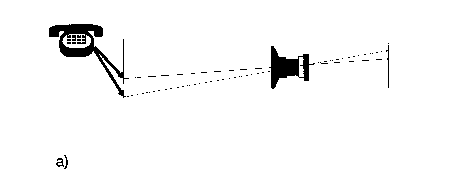
We assumed that the aperture of the photographic objective is very
small, as if we were dealing with a pinhole camera.
In figure b) we have the film already developed and assume that he
has the perfect condition of registerig and reproducing the wavelength
of each ray. Now, he is transilluminated from behind with white light in
all directions and we can see by analysis that only two rays which
are reciprocal to the two registered rays are the only ones to make the
indicated path, inverse to that of registering.
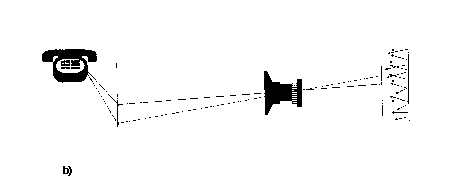
We can obtain in that way the image of an object exactly at its
original position, but can only be see for anobserver located at a
position where he can be reached for that rays. That is, from the
opposite side to the viewpoint of the camera (upper left side, in this
case).
The observer sees the image inverted in depth (pseudoscopic).
Fortunately, there are two simple ways to make it to be seen in natural
relief: by inverting the photographic film or changing the viewing to
the symmetric diffracted observed order.
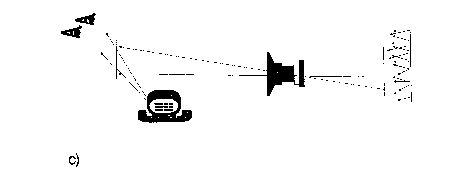
In figure c) we inverted the film. Observe carefully and
you can verify that the ray that was below in figure b) is
above now and the their virtual prolongation makes it to reach the
virtual prolongation of the other ray. We obtained a virtual image in
normal relief, what can be cheked by analysing the symmetry of the
situation for any other object points.
This analysis is correct and we made experiences with ordinary color
film obtaining results which are visually approximated of our
desired solution. We know that the result coul be perfect if the film
could reproduce perfectly wavelengths. Color film reproduces
reasonable well the sensation of color, but not the wavelength.
That is, the visual sensation, not the distribution of wavelengths.
Fortunately in this case too, there is a tecnic which reproduce
wavelengths, Lippman photography, by G. Lippman, Nobel prize of Physics in 1908,
already referred at the begining of this site on holography.
See a
photograph of a Lippman photograph
Applying Lippman photography to our procedure we will have holograms
registered under white light. We are trying to reproduce those old
techniques, not in the same way, but in such a way that could be easier
to work and employing holographic film instead of trying to reproduce
Lippman plates.
For a more complete description, I include below other schemes for
the same technique but employing for projection a special diffracting
screen I invented.
We see in 1) the position of the images of a cubic object at
the registering stage. Its color is directly related to its
wavelength.
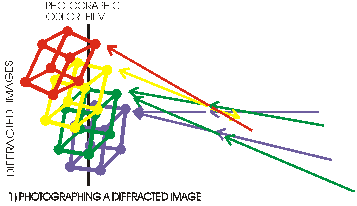
Due to the large focal depth we obtain the result as a compression
wich puts the volume images on the plane of the film.
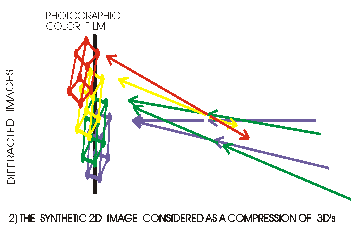
Some rays appear in figure 2) also with inverse direction,
just to anticipate figure 3) where every ray have makes the path
which is inverse to that of the corresponding rays of the registering.
Those reciprocal rays are the only ones that can reach the center of the
lens.
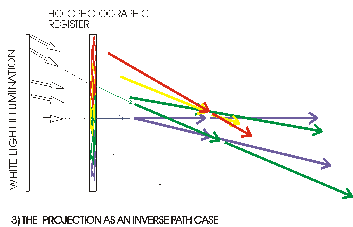
In figure 3) we have the situation of inverse path that,
being exactly drawn, would show every ray going to the same point, the
center of the photographic objective.
Finally, in the figure below, I put a more complete scheme, with
some inclination of the film for appropiated focusing at the screen and
where we can perceive that color reproduction can not be achieved,
because the wavelength of each observed ray changes according to the
observer's position.

References:
- "The
encoding of depth by spectral diffraction", artigos básicos
- "New possibilities in the
utilisation of holographic screens", Proc. of the SPIE meeting
"Electronic Imaging", conference "Practical Holography VI", San
Jose-CA-USA, 1992.02.9-14, p.289-293.
- "White-light color-encoded photography for rendering
holo-images in a diffractive screen", published in Proc. of the
Fourth Intl.Conf. on Holographic Systems, Components and Applications,
University of Neuchatel, Switzerland, 13-15.09.93, p.153-155. Details of
a previous proposal of an original technique for registering
holographic-like images without needing laser.
BACK
TO THE MAIN PAGE






